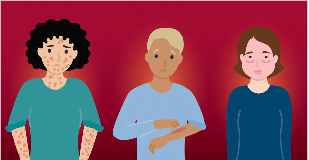Mast Cell Activation Syndrome (MCAS)
Mast Cell Activation Syndrome (MCAS)
What is mast cell activation syndrome (MCAS)?
Mast cell activation syndrome (MCAS) is a condition when someone experiences repeated anaphylactic episodes due to high levels of mast cell mediators being released more frequently and/or a patient experiences an allergic reaction from things that are not considered harmful such as food or other triggers such as fragrances, stress, and changes in temperature. The cause and estimated number of people with MCAS are currently unknown due to how rare the disease is. It is sometimes considered idiopathic meaning it is not caused by any other disease or related to a specific allergy or cause. MCAS diagnosis is determined by whether the symptoms occur in separate attacks and if they occur without a clear cause as well as clinical exams and laboratory testing
What are mast cells?
Mast cells are immune system cells that help protect against infections. They are responsible for immediate allergic reactions by releasing “mediators” stored inside of them. During an allergic reaction, the mediators are released when allergy antibodies on mast cell surfaces called IgE bind to proteins called allergens which are responsible for allergies. Mast cells can also release mediators by other means such as medications, infections, and insect or reptile venom.
Mast cells can sometimes be defective and release mediators due to abnormal internal signals. Mast cells can also sometimes produce identical mast cells called clones that can spontaneously release and produce excessive mediators.
What are the symptoms of MCAS?

MCAS-related symptoms can range from mild to severe to life threatening depending on the organs affected, the number and frequency of mast cells released, and the type and consequences of comorbid conditions. If symptoms are recurrent, involve more than one organ system, and are responsive to mediator-targeting therapy, it can be considered a diagnosis of MCAS.
Most anaphylactic symptoms include:
- Itching
- Hives
- Swelling
- Flushing
- Low blood pressure
- Rapid pulse
- Shortness of breath
How is MCAS diagnosed?
Diagnosing MCAS is complicated as patients would have to see multiple doctors and partake in multiple diagnostic tests. There is also no specific test doctors may use to properly pinpoint MCAS. Many healthcare experts will test for certain markers such as tryptase and histamines to help with determining an MCAS diagnosis.
Specifically, doctors may look for:
- Chronic or repeating allergy symptoms in more than one organ system
- Higher than normal tryptase, histamine, or prostaglandins in blood
- Relief of symptoms after using antihistamine medications
How is MCAS treated?
MCAS is treated both prophylactically and actively with a focus on symptom relief. It is important to advise people with MCAS and family members to avoid any triggers or situations that can cause an allergic reaction. People with MCAS should take prophylactic allergy medication for their entire life and carry two or more adrenaline autoinjectors (EpiPens) after being trained with them in case of an emergency event where symptoms are severe. First generation antihistamines such as diphenhydramine and hydroxyzine may be used for itching and flushing but are not as preferred compared to second generation antihistamines such as loratadine and cetirizine due to side effects such as drowsiness.
What medications are used to treat MCAS?
| Classification | Drug Name | Instructions | Side Effects | Additional Notes |
|---|---|---|---|---|
| 1st generation antihistamines | Diphenhydramine (Benadryl®) | Take 25 mg every 4 to 6 hours | Drowsiness, sleepiness, upset stomach | Not as recommended compared to 2nd generation antihistamines |
| Hydroxyzine (Vistaril®) | Take 10 to 25 mg 3 to 4 times a day as needed for rash | |||
| 2nd generation antihistamines | Cetirizine (Zyrtec®) | Take 10 mg once daily | Drowsiness and dry mouth | |
| Loratadine (Claritin®) | Take 10 mg once or 5 mg twice daily | Drowsiness and headache | ||
| Leukotriene receptor antagonist | Montelukast (Singulair®) | Take 10 mg once daily | Headache, stomach pain. cough | Only recommended for those who do not respond to other allergy medications or in those who have coexisting asthma |
| Alpha-/Beta/ Agonist | Epinephrine (EpiPen®) | Inject 0.3 to 0.5 mg once. Repeat every 5-15 minutes if there is no response to the initial dose | Dizziness, drowsiness, weakness, anxiety |
What are inactive medication ingredients?
Inactive ingredients, also known as fillers, are “any component of a drug product other than an active ingredient” according to the US Food and Drug Administration (FDA). These ingredients are not to have a biological or therapeutic effect and are instead used to change physical properties of oral medications to help with absorption, stability, taste, appearance. Inactive ingredients can include food products such as lactose and corn starch, food dyes, sugars such as sucrose and mannitol, and polymers such as PEG.
The most common inactive ingredients that can act as allergens are:
- Lactose
- Cornstarch
- Polyethylene glycol (PEG)
- Povidine
- Carboxymethylcellulose
- Gelatin
- Certain dyes: brilliant blue, sunset yellow FCF, allura red, indigo carmine
- Propylene glycol
- Mannitol
- Sucrose
What can we offer?
Here at CareFirst Specialty Pharmacy, we can compound medications free of problem-causing excipients such as dyes, sugar, lactose, or alcohol.
Inactive ingredients that we can use in our compounded products include:
- Microcrystalline cellulose (MCC)
- Sucrose
- Mannitol
- Acidophilus®
- Loxoral
- Vitamin C
- Lactose
- Ginger root
- Turmeric powder
- Sodium bicarbonate
- Magnesium glycinate
- Magnesium citrate
If you are looking for any of your medications to be compounded without any possible problem-causing fillers, you can contact CareFirst Specialty Pharmacy located at 400 Fellowship Road, Mount Laurel Township. NJ 08054.
CareFirst Specialty Pharmacy Phone number: 844-822-7379
References
- Mast cell activation syndrome [Internet]. Milwaukee: American Academy of Allergy Asthma & Immunology; [cited 2022 Nov 2]. Available from: https://www.aaaai.org/conditions-treatments/related-conditions/mcas.
- Valent P, Akin C, Nedoszytko B, Bonadonna P, Hartmann K, Niedoszytko M, Brockow K, Siebenhaar F, Triggiani M, Arock M, Romantowski J, Górska A, Schwartz LB, Metcalfe DD. Diagnosis, Classification and Management of Mast Cell Activation Syndromes (MCAS) in the Era of Personalized Medicine. Int J Mol Sci. 2020 Nov 27;21(23).
- Reker D, Blum SM, Steiger C, Anger KE, Sommer JM, Fanikos J, Traverso G. "Inactive" ingredients in oral medications. Sci Transl Med. 2019 Mar 13;11(483).
- Mast cell activation syndrome [Internet]. Gaithersburg: Genetic and Rare Diseases Information Center; [updated 2021 Nov 8; cited 2022 Nov 2]. Available from: https://rarediseases.info.nih.gov/diseases/12981/mast-cell-activation-syndrome.
- Brennan D. What is mast cell activation syndrome? [Internet]. WebMD; [updated 2021 Apr 12; cited 2022 Nov 2]. Available from: https://www.webmd.com/allergies/what-is-mast-cell-activation-syndrome

Comments